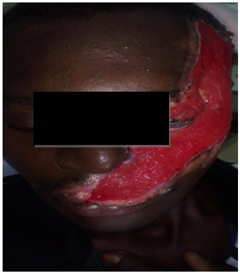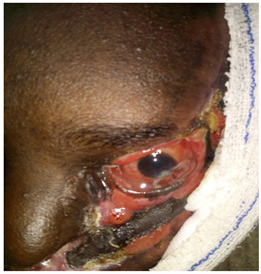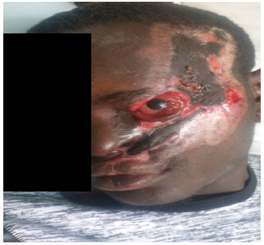Palpebral Reconstruction in a Secondary Ophthalmology Center in Mali: About a Case ()
1. Introduction
Injuries to the periorbital region are increasing in Sikasso Hospital due to the evolution of the road infrastructure. Periorbital traumas are most often associated with other lesions (maxillofacial, cranial and polytraumatized). These traumas are most often due to public road accidents (AVP), burns, accidents during work rural and ballistic or other brawls. Public road trauma accounted for 78% of the causes of head trauma at Gabriel Touré Hospital from 2011 to 2012 and 80.3% of facial trauma at the CHU-CNOS (Centre Hospitalier Universitaire-Center National d’Odonto Stomatologie) in Bamako from January to December 2014 [1] .
Significant trauma to the periocular region can seriously damage ocular structures and their adnexa.
Palpebral involvement is often associated with lesions of the forehead, eyebrows and cheeks. Burns affect the eyelids in 7.5% to 27% of cases in adults, and they concern 71.7% of facial burns in children [1] .
The eyelids can be damaged during these traumas. The most frequent lesions are lacerations, the surgical treatment of which is generally simple. In some cases, there are complex traumas where there is a loss of tissue, which is difficult to treat.
At Sikasso Hospital, we do not have a study on periorbital trauma, despite the high frequency of admissions to the emergency services for trauma related to road traffic accidents.
We report the case of a 26-year-old young man, farmer with no medical and surgical history, referred by the odontostomatology and maxillofacial surgery department for burns to the left hemi face by the exhaust pipe of his motorbike which occurred following a public road accident (AVP).
2. Observation
This was a 26-year-old young man with no particular history referred by the maxillofacial surgery department for management of eyeball exposure, keratitis and post-traumatic lagophthalmos after a motorcycle traffic accident.
The external examination found a wide wound of the hemiface about 20 cm long on its long axis and 10 cm wide, with a significant loss of the upper left eyelid superior to three quarters of the eyelid and a burning of the epidermis of the lower left eyelid.
Visual acuity was 10/10 in the right eye and 5/10 in the left eye with an intact eyeball and good globe mobility. There was a total loss of the upper eyelid, muscle and fat wasting resulting in lagophthalmos and serous secretions.
On biomicroscopic examination, conjunctival hyperaemia and superficial punctate keratitis were observed in the left eye. In addition, the integrity of the anterior chamber, pupil and iris was noted, with a good normal photomotor reflex.
The intraocular pressure taken in the air as well as the fundus taken with the Volk 90 lens was normal in both eyes. The radiography of the facial mass (face/profile) and computed tomography (CT scan) of the skull did not find any anomaly or foreign body. The blood work was also unremarkable. Blood sugar was 100 mg/dl, prothrombin Rate (PR) was 92%, creatinine was 10 mg/l, the blood count formula was normal.
In collaboration with the maxillofacial surgeon, a graft of the hemi face was performed using a flap from the inner side of the thigh first, combined with medical treatment with antiseptic eye drops, wetting of the ocular surface and corneal healing agents.
After three months of follow-up in the maxillofacial surgery department, the patient was referred to us for management of the palpebral inocclusion (lagophthalmos) (Figure 1).
 (a)
(a)  (b)
(b)
2 Months
 (c)
(c)  (d)
(d)
3 Months
Figure 1. Image of patient (a): seven days after admission to the emergency room; (b): One month after hemifacial graft break; (c): two months after break of the hemifacial graft; (d): three months after placement of the hemifacial graft and 3 weeks after placement of the flapsupra eyebrow.
Faced with the evolution of the corneal ulceration and the risk of greater loss of vision, recovery by a flap graft was performed, which consisted of removing a myocutaneous flap above the eyebrow and suturing it with silk 6/0 at remaining anterior eyelid edges and eyebrows with separated points followed by a progressive ablation due to one point out of two from the seventh day. This recovery allowed us, despite fragile tissue vitality, to have a considerable reduction in lagophthalmos and to obtain complete healing of the corneal ulceration. Four weeks after placement of the myocutaneous flap, despite slight retraction of the graft and excision of necrotic tissue. We suggested the need for a second intervention at the level of the upper eyelid finally to carry out the positioning of the posterior lamella by a tarso-conjunctival flap. Despite the explanations and the advantages offered by this second intervention, especially on the functional level. The patient already judged the aesthetic state of his face very satisfactory and preferred to return to his village still refusing any other surgical intervention.
3. Comment and Discussion
The Sikasso region is considered the second largest city in Mali in terms of population but also with the highest number of traffic accidents after Bamako [2] . There are many reasons that cause accidents on our roads (lack of suitable infrastructure, incivility, carelessness, etc.). At the Sikasso hospital, we do not have statistics on road traffic accidents. Our patient was received in the context of a public road accident with a burn of the hemi face by the exhaust pipes of the motorcycle. Through a study, “Evaluation of road safety and associated trauma in the city of Sikasso”, carried out by Emmanuel Bonnet [2] , health geographer and researcher at the IRD (Research Institute for Development) in 2019 showed that more than 75% of accidents in the city of Sikasso involve pedestrians or motorcyclists. Young people are the first victims’ road accidents with more than 53%. Our patient was 26 years old, close to the slice of E Bonnet who found that young people between 18 and 24 years old constitute each year more than 25% of the killed and 23% of the injured. The age of our patient was lower than the average age found by AS Sangaré et al. which was 39 years (2 to 73 years) in Mopti but the age group of 18 - 27 was the majority in this study. [3] . In Senegal A. Lam et al. found an average age of 8.5 years much lower than the age of our patient for an age group of 6 to 10 years most affected [4] probably linked to the fact that this study only concerned children under 15 years of age. The eyelid involvement was associated with other local lesions, namely keratitis, burning of half of the left face, this association is known to several authors, especially when they occur in the context of a public road accident. M Sissoko et al. found eyelid lesions (78.25%) at CHU IOTA in 2020 following an accident that occurred during the confinement of the COVID-19 pandemic [5] . Surgical management of these lesions is often delayed because of the associated vital lesions. The patient most often passes through other departments before ophthalmology, such was the case of our patient who spent a long time in the maxillofacial department before being referred to ophthalmology.
Despite the delay in the surgical management on the ophthalmological level, our patient benefited from medical treatments (Wetting agents of the ocular surface and physiological saline) seven days after his admission to the emergency department at the hospital, which allowed us to have a satisfactory visual acuity of 5/10 in the affected eye. Especially since the quality of the functional and aesthetic result depends on the precocity of the assumption of responsibility.
The reconstruction of an upper eyelid being more complex than that of a lower eyelid because of its proximity to the eyeball and its function in all lacrimal physiology, lid blinking and eye protection. Ideally, the ipsilateral or contralateral upper eyelid provides the best grafts for reconstruction. The pretarsal portion of the retroauricular skin constitutes the second donor site, rather on the posterior surface of the pavilion than at the mastoid level, due to the difference in the thickness of the skin [6] .
We carried out a recovery using a frontal flap because of the importance of the loss which was greater than three quarters of the eyelid and the urgency to protect the eyeball as well as the state of our technical platform at the Sikasso Hospital. The choice of technique was mainly motivated by its mastery but also by the quality of our technical platform. Because we do not have at the Sikasso Hospital an adequate technical platform for eyelid and orbit surgery. Also our patient had lesions such as scratches and micro wounds on the appropriate sampling sites (micro wounds, scratches).
Other techniques, in particular that of the Tenzel flap reversed, are used especially in the losses of nasal substances or Cutler-Beard. These techniques being more complex little mastered and require an adequate technical platform were not chosen by our team.
The Abbot’s flap was not chosen because a transposition of the lower eyelid to the upper one was difficult due to the importance of the burn of the hemiface [7] .
The difficulties of eyelid reconstruction are related to the anatomical and aesthetic particularities of the eyelids. These peculiarities have been reported by J. Bouguilaand all [7] . They are mobile and fragile with a complex structure [8] , explaining the difficulties of the functional and anatomical management of these lesions of palpebral burns [9] . This most often requires multiple surgical acts, as in our case, where there was a need for a second surgery. Although the explanations on the advantages of this second intervention were given, the patient judged satisfied with the aesthetic state of his face and refused any other surgical intervention.
As for aesthetics, it depends on the severity of the burn and the anatomical and functional disorganization of the eyelids. It is recalled that the eyelid aesthetic extends to the orbital rim externally and towards the glabella internally, going well beyond the external and internal canthus. [10] . The limits are estimated at 0.5 cm inside the internal canthus and 1.5 cm outside the external canthus [9] [11] . The eyelids are held to the bony orbital frame by internal and external palpebral ligaments which attach them to the internal and external orbital rims; the second means of attachment is represented by the orbicularis muscle. The weakness of these attachments explains that these anatomical structures essentially depend on retractions and scar tensions. [9] . The eyebrows also play an important role in the aesthetic balance of the look. All it takes is a badly positioned eyebrow, or one whose hair grows in the wrong direction, to give the face an incongruous and grotesque appearance. The bristles are vertical and oriented slightly outwards in the inner part, laterally in the central part, outwards and slightly downwards in the outer part [12] .
Our decision to take charge of this patient was above all justified by the urgency to protect the globe as well as the very limited means of the patient who made a trip to the capital in Bamako.
4. Conclusion
Reconstruction of the eyelid after a road accident or a major burn is a real problem in our department and in our developing countries because of the slowness of the treatment but especially because of the difficulty of a rapid multidisciplinary treatment. The insufficiency of the technical platform and the availability of consumables limit us in the choice of the operative technique. This reconstruction is also a problem of adherence for the patient, to multiple surgical procedures and also the management of sequelae.